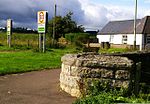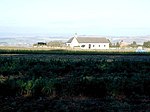Clocksbriggs railway station
1848 establishments in Scotland1964 disestablishments in ScotlandDisused railway stations in Angus, ScotlandFormer Caledonian Railway stationsPages with no open date in Infobox station ... and 7 more
Railway stations in Great Britain closed in 1917Railway stations in Great Britain closed in 1955Railway stations in Great Britain opened in 1848Railway stations in Great Britain opened in 1919Scotland railway station stubsTayside stubsUse British English from July 2018

Clocksbriggs railway station served the town of Forfar, Angus, Scotland from 1848 to 1964 on the Arbroath and Forfar Railway.
Excerpt from the Wikipedia article Clocksbriggs railway station (License: CC BY-SA 3.0, Authors, Images).Clocksbriggs railway station
B9113,
Geographical coordinates (GPS) Address External links Nearby Places Show on map
Geographical coordinates (GPS)
| Latitude | Longitude |
|---|---|
| N 56.6564 ° | E -2.8239 ° |
Address
Clocksbriggs
B9113
DD8 2TG
Scotland, United Kingdom
Open on Google Maps







